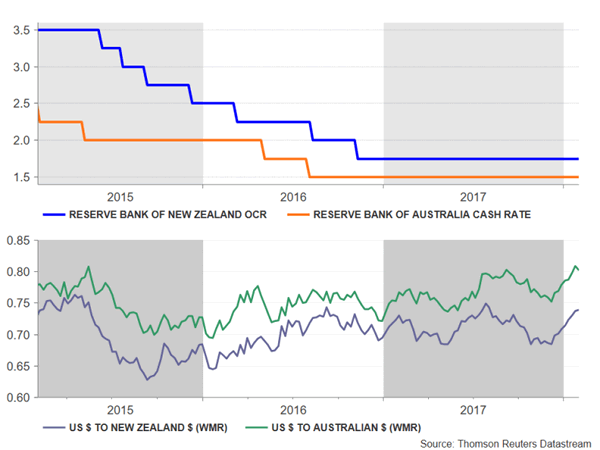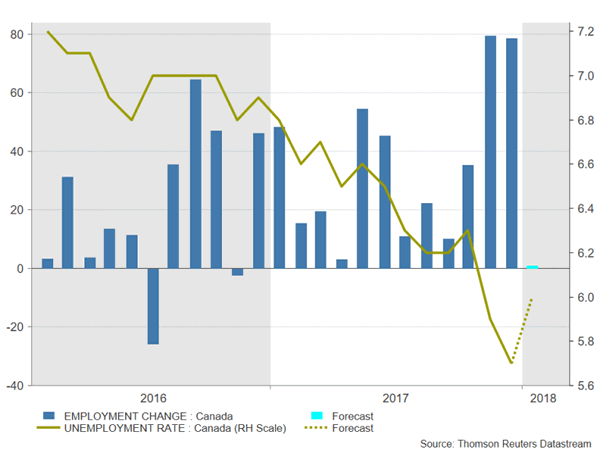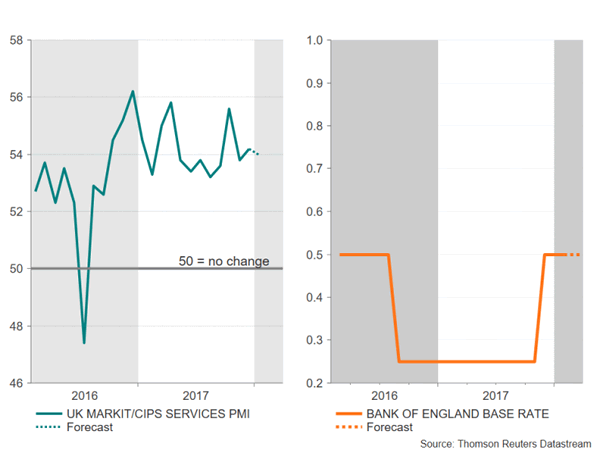Central bank meetings will dominate next week’s economic calendar as the Bank of England, the Reserve Bank of Australia and the Reserve Bank of New Zealand meet to set monetary policy. All three are expected to stand pat but surprises could be in store for the markets as policymakers adjust their outlook following recent developments pertaining to their economies and in forex markets. Economic data will not go amiss with most countries releasing monthly figures on trade and services PMIs.
Soaring aussie and kiwi a concern for the RBA and the RBNZ
Weaker-than-expected inflation in Australia and New Zealand has kept the RBA and the RBNZ on hold even as growth has remained solid and the labour market has been improving in both countries. Fourth quarter inflation numbers released last month showed Australian CPI rising by less than anticipated and missing the RBA’s 2-3% target band for the third straight quarter, and in New Zealand, the annual rate unexpectedly fell by 0.3 percentage points.
And while growth in the two Asian-Pacific economies has picked up some steam, a sharp appreciation in the exchange rate threatens to depress growth and dampen already subdued inflationary pressures. The aussie gained just over 8% versus its US counterpart in 2017 and is up a further 2.5% so far in 2018. The kiwi rose by a more modest 2% last year but has rallied almost 4% in January.

Both the RBA and RBNZ could toughen their language on the exchange rate in their upcoming meetings on February 6 (Tuesday) and 8 (Thursday) respectively. However, investors are likely to ignore such comments if the central banks also raise their outlooks on the economy as this would bring forward expectations about the timing of a rate increase. Based on recent data, the RBNZ is more likely to strike an upbeat tone, while the RBA could sound more cautious.
Aussie traders should be braced for additional volatility on Tuesday as Australian retail sales and trade figures will be published ahead of the RBA announcement. Moreover, the RBA will publish its quarterly Monetary Policy Statement on Friday, giving a more detailed insight into the Bank’s updated economic projections. In New Zealand, fourth quarter employment data due on Wednesday will provide traders with the final clue as to what to expect from the RBNZ the following day.
Loonie eyes Canadian jobs report
Concerns about NAFTA drove the Canadian dollar to retrace half of its gains in 2017 that were made on the back of the Bank of Canada joining the rate hike bandwagon. But the loonie is once again heading higher and this week hit a 4-month top of C$1.2246 to the US dollar. A stronger-than-anticipated employment report on Friday could help the Canadian dollar target the C$1.20 level again. Also to watch out of Canada in the coming week are trade figures and the Ivey PMI on Tuesday.

China releases trade and inflation numbers
With risk aversion making its first appearance of 2018 this week, markets could be sensitive to economic indicators out of China in the next seven days. Trade data on Thursday will be watched to see how China’s exports and imports fared in January. Inflation figures will follow on Friday, which will include both the consumer and producer price indices for January. The yuan touched a 2½-year high of 6.2677 per dollar this week, with the PBOC seemingly at ease with a stronger currency, even though China’s economy appears to be heading for softer growth this year. Strong numbers next week would reinforce the view that China is only headed for a mild slowdown.
Quiet week for the US and the Eurozone
It will be a quieter seven days for the US and the Eurozone with only a handful of major data releases. In the US, the highlight will be the ISM non-manufacturing PMI due on Monday. The closely watched indicator of services activity in the United States is expected to improve to 56.3 in January, from 56.0 in the prior month. December trade figures and the JOLTS job openings could also attract some attention on Tuesday.
Looking at the European calendar, business surveys will start the week on Monday, which will include the Eurozone final services PMI readings for January, as well as December retail sales and the sentix index for February. However, industrial output and trade data out of Germany and France are likely to prove more exciting for traders. German industrial production data is due on Wednesday, followed by the trade numbers on Thursday. The French trade figures will be published on Wednesday, with the industrial output number coming out on Friday. The data are unlikely to give the euro much direction, which could be headed for another week of consolidation versus the greenback.
Will Bank of England flag a rate hike?
The Bank of England is widely expected to hold interest rates unchanged at 0.5% when it convenes on Wednesday and Thursday, but the meeting could still be an eventful one as the Bank will also publish its quarterly inflation report on Thursday and will be followed by a press conference with the Governor Mark Carney. Markets may have already gotten a glimpse as to what to expected from Carney from his testimony before Parliament’s Economic Affairs Committee earlier this week. Carney said "the focus is increasingly on returning inflation sustainably to target over an appropriate horizon". This perhaps is a signal that rates may need to be raised sooner, possibly in May or August, than the current market forecasts of November.

The pound gained on the back of Carney’s remarks, climbing back above $1.42. A not-so-hawkish than expected BoE could send sterling below $1.40 but UK data also poses a risk. The January services PMI is due on Monday. Given that services accounts for 80% of UK GDP, it will be important to see how the sector performed at the start of the year. The index is forecast to moderate by 0.2 to 54.0 in January. Other data will include industrial and manufacturing output figures on Friday, alongside the trade balance, all for December.











